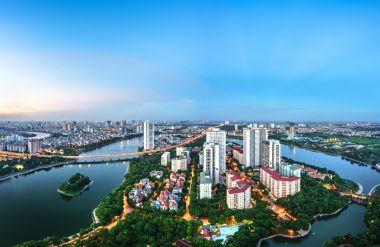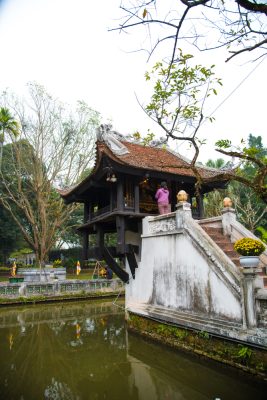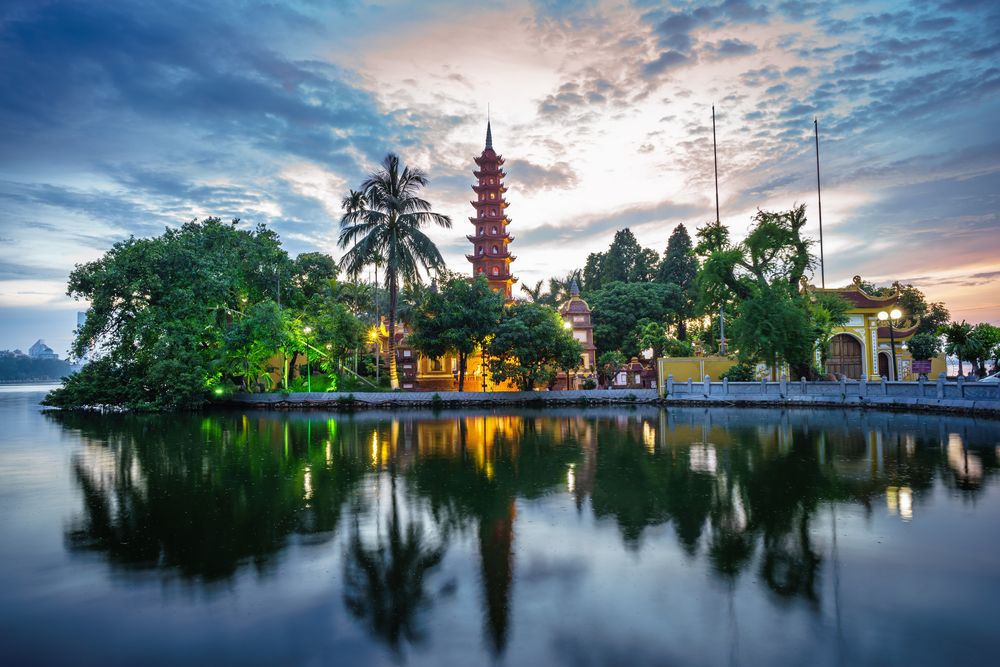Hanoi is not only one of many cities in Vietnam (and with a total population of over 90 million, there are plenty of cities, many even with their own airports), no, Hanoi is so much more than that. Hanoi may be much smaller than Ho Chi Minh City (also known as Saigon), but it is much more culturally significant.
It is the capital of the country, which is still ruled by communist-socialists. And also the place where the “father of the nation” as it exists today is buried: Ho Chi Minh. His mausoleum is visited by hundreds of thousands of people every year.
The mausoleum, some more modern statues and monuments, often dedicated to the workers or heroes of the Vietnam War, and official buildings, such as post offices, show the country’s typical communist architecture. But Hanoi also has what many other Vietnamese cities lack: history. In the “Old Quarter”, the streets are narrowly lined with narrow, tall houses. While families often live on the upper floors, the lower floor belongs entirely to the hustle and bustle of the street: souvenir shops, cafes, restaurants, cookshops and crafts.
The shops of Hanoi

One of the typical aspects of downtown Hanoi is that entire streets often sell exactly identical things: for example, there is a street where there are only jewellers and jewellery shops. Another street is lined with shops where metal goods, ladders, chains, pipes, etc. are stacked all the way out to the street.
As a pedestrian, you always have to keep your eyes open here, but this is not difficult with the multitude of colors, lights, scents and sounds. On still other of the typical streets of the city center, for example, only decorations for weddings are sold (and Vietnamese do not skimp on glitter, pomp and color).
These very specialized shops offer a wonderful insight into the tastes and traditions of the Vietnamese. Since in Vietnam people get married very young and always in a large company, which often happens in tents on the street due to lack of space in houses, tourists also have a realistic chance to take a look at a Vietnamese wedding.
The Hoan Kiem Lake
Hanoi is particularly known for its centerpiece, Hoan Kiem Lake. Legend has it that a turtle here presented the young Le Loi with a magic sword, with the help of which he defeated the Ming Dynasty and eventually ascended the throne as Vietnam’s first king.
As a thank you, he is said to have later had the so-called turtle tower built in the lake. While this can only be admired from the shore, there is a temple on the lake, which can be reached with the help of a red bridge (which, by the way, is beautifully illuminated at night). A turtle is exhibited here, which was recovered from the lake in 1968. But even without a visit to the temple, Hoan Kiem Lake is one of the most beautiful places in Hanoi.
On a walk around the manageably large lake, you can see Vietnamese life and hustle and bustle par excellence: wedding couples with a photographer who absolutely want a photo with one of the most popular backgrounds in the country for their wedding photo album. Elderly ladies standing in a long row behind each other and massaging each other. Badminton playing residents, others lifting weights, others playing chess or practicing Qi Gong and also interested people who want to practice English with tourists.
The climate in Hanoi
Summer (May to October)
- Summer in Hanoi is typically very hot and humid. Temperatures are often between 28 °C and 35 °C.
- This time is also characterized by the southwest monsoon, which brings a lot of rain. July and August are the rainiest months.
Winter (November to April)
- The winter months are cooler and drier. The average temperatures are between 15 °C and 20 °C.
- There is less rain than in summer, and the air is often dry. December and January are the coldest months.
In the transitional periods between the main seasons, temperatures and weather conditions can change rapidly. It can also get foggy in Hanoi during the winter months, which sometimes affects traffic. Despite the coolness in winter, the humidity is relatively high throughout the year, making the climate in Hanoi very warm and humid for a larger part of the year.
Attractions in Hanoi

If you still don’t think that Hanoi is worth a visit, you should take a look at some of the sights.
Temple of Literature Hanoi
On the one hand, there is the Temple of Literature, often called the “oldest university” in the country. This complex of gardens and symmetrically arranged courtyards, buildings and shrines was built in the 11th century by followers of Confucianism and still exudes a wonderful peace and relaxation today.
Ho Chi Minh Museum
If you are more interested in the country’s recent history or want to learn more about the man depicted on every single Dong banknote in Vietnam, a visit to the Ho Chi Minh Museum is recommended. The reporting is not always completely impartial, but you learn a lot about the circumstances from which Ho Chi Minh came, how and where he gained and developed his ideas and conceptions. You can tell what influence he exerts on the population of Vietnam to this day.
One Pillar Pagoda
Located just a few minutes’ walk from this huge museum is the One Pillar Pagoda – a special landmark of the city. For centuries, this pagoda actually stood on a single wooden pole. Unfortunately, this has long since been replaced by concrete, but you can still feel the magic of the place. According to legend, King Ly Thai Tong had the pagoda built here as a thank you to the goddess of mercy.
The king had remained childless for a long time when, in a dream, the goddess presented him with a child at the place where the pagoda stands today. In fact, he became a father shortly afterwards, which is why he subsequently had the one-pillar pagoda built.
Ethnological Museum of Hanoi
A little further from the city center, but not a bit less worth seeing, is the Ethnological Museum of Hanoi. The covered part of the exhibition is located inside the building, which is round in shape like the national symbol, the bronze drum. Here you can discover a lot of interesting facts about the 54 tribes that live in Vietnam: their crafts, tools, textiles, etc.
The highlight, however, is the outdoor complex of the museum. Members of various Vietnamese tribes have built traditional houses here in real size. Visitors to the museum are even allowed to walk through them. If you are still not convinced, you should research the typical cuisine of Hanoi, at the latest then you are under the spell of the city!


